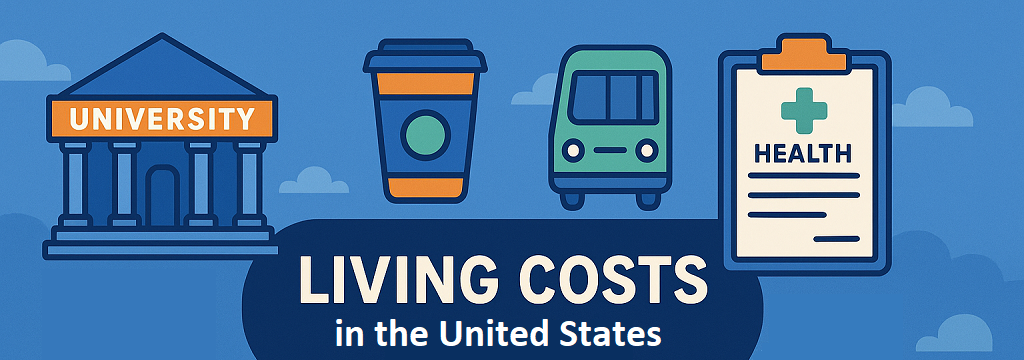
To have a fulfilling academic experience in 2026, students must carefully manage living costs in USA. Home to prestigious universities and diverse educational opportunities, the US remains a top destination for academic pursuits. However, these benefits come with financial responsibilities that affect daily life. Understanding these study and living costs in USA, e.g., university tuition fees, public transportation, health insurance, food, groceries, recreation, and housing, is essential. With the post-COVID economy still in recovery and inflation at ca. 2.5% in 2025, students face increasingly complex financial challenges. This blog breaks down the main categories of living expenses in USA, additional costs of living for international students in USA, and offers practical tips for managing them effectively.
Factors Influencing Living Expenses in USA
Regional Variations on Living Costs in USA
Living costs in USA vary greatly by state and city across the country. The five most expensive cities on the list are New York, Los Angeles, San Francisco, Boston, and Washington D.C., where monthly costs frequently surpass $2,500, excluding university tuition fees. Smaller cities such as Athens, Georgia, or Houston cost between $1,200 and $1,500. This requires students to balance affordability and academic prestige. Cities like Chicago provide a compromise between moderate costs and urban accessibility. Your budget is also influenced by the campus location you select. Here is a list of five different cities from five US states with monthly cost ranges in accommodation:
1. New York City, New York ($1,200 – $3,500): New York City is known as one of the most expensive cities worldwide, and student living costs are quite high. If you choose to live in Manhattan, expect extremely high rent. However, other boroughs like Brooklyn or Queens offer more affordable housing options. The city boasts a strong economy with thriving and diverse industries such as digital media, biotechnology, software development, game design, computer hardware, etc.
2. Los Angeles, California ($800 – $2,800): Los Angeles offers a wide range of housing options, from luxury apartments to shared accommodations. Transportation is another major factor to consider, as most residents rely on cars rather than public transit. Overall, the cost of living in Los Angeles is 8% higher than the California state average and 51% above the national average.
3. Boston, Massachusetts ($1,100 – $3,000): Over the past decade, Boston has emerged as one of the most expensive cities in the USA for renting an apartment, surpassed only by New York City and San Francisco in terms of average rent prices. Despite the high cost of living, particularly for housing, Boston is a vibrant city known for hosting two of the best universities in USA, i.e., Harvard and MIT.
4. Chicago, Illinois ($800 – $1,500): Chicago offers a more budget-friendly alternative to cities like New York and Los Angeles. It features excellent public transportation and relatively affordable rent. While student housing costs in Chicago may exceed the national average, expenses can vary widely depending on location and property type. Shared housing and university dormitories often provide more affordable options for students.
5. Houston, Texas ($600 – $1,200): With its low cost of living, Houston has become a popular choice for the growing number of international students seeking more affordable housing. According to University Living, the overall monthly cost of living in Houston, including rent, groceries, transportation, and other expenses, is approximately $1,500. Overall, Houston’s cost of living is estimated to be about 6% below the national average.
Inflation and Economic Trends
Inflation has a significant impact on student living costs in USA, making it more difficult to afford everyday essentials such as housing, food, and transportation. As prices rise, purchasing power declines, meaning students need more money to cover the same expenses. This can lead to greater financial stress and make it harder to focus on academics. When planning financially, students must account for these gradual increases. It is undeniable that economic trends influence both lifestyle and budgeting. This pressure is especially noticeable in the living costs in USA, particularly in coastal states such as California, Florida, Massachusetts, New York, and Washington.

Breakdown of Key Living Costs in USA
Imagine Iman, studying a master’s degree in USA at the University of Texas at Austin in 2025. His monthly expenses in the USA total $1,400, including $700 for a shared apartment, $250 for groceries, $40 for a bus pass, $120 for utilities and internet, and $270 for books and social activities. He saves around $800 per month from a part-time job. The remaining living costs in USA, along with tuition fees at the University of Texas at Austin, are covered by his father. His budget is challenged by the cost of living in America, but cooking at home and using discounts help him stay on track. Keep in mind that this is a personal estimate, so your expenses may vary.
Student Housing Costs in USA
Housing and accommodation make up the largest portion of student living expenses in USA, as in most countries. The type of housing (house, apartment, studio, etc.) and its location (on-campus or off-campus, whether in the city center, suburbs far from the center, or near the university) play a key role in determining cost. While rent is generally lower on rural campuses, transportation costs can offset those savings. On-campus dormitories are in high demand, so it is best to apply early if you are interested. In the Midwest, options like Iowa State typically range between $600 and $900 per month.
A common strategy among students is to share an apartment with roommates, which can reduce rental costs by ~30%. US citizens have the opportunity to enroll in a university located in their hometown/city and still live with their parents, which hugely reduces the living costs in USA. Unlike domestic students, the average cost of living for international students in USA is higher because they don’t have the option to live with their parents.
Food and Groceries Expenses in the US
With an average monthly cost of $250 to $400 in 2025, food represents a significant portion of living costs in USA. Frequent takeout or campus dining can noticeably push the costs up to $600, while shopping at budget-friendly stores like Walmart can keep expenses closer to $200. Home cooking becomes essential if you are on a tight budget or lack financial support from the government or universities. Food costs may also contribute to the rising cost of living for international students in USA, for those who purchase specialty items. For instance, Indian or Persian food often includes expensive spices like saffron. Your eating habits directly influence your food expenses, and small daily choices can make a big difference over time.

Utilities and Internet Costs in USA
In the USA, utilities such as heating, water, and electricity typically add between $80 and $150 to the monthly cost of living and are often included in dormitory fees. Due to energy prices still reflecting the spikes of the early 2020s, private renters may pay between $150 and $200 per month. The internet, an essential resource for students, usually costs between $40 and $70. Opting for energy-efficient appliances or sharing bills with roommates can help reduce utility expenses. In colder regions, especially along the East and Northeast coasts, winter heating can significantly increase costs, contributing to seasonal variations in living costs in USA.
Transportation Costs for Students in USA
Transportation is a key factor influencing living costs in USA, and it varies based on urban density. Owning a car (including expenses for maintenance, fuel, and insurance) can exceed $300 per month. In contrast, public transportation or student passes in cities like Los Angeles typically range from $50 to $100 per month. In smaller towns, walking and bicycling are free and viable options. Many coastal hubs offer discounted student fares; for example, the NYC MTA monthly pass costs $87 for regular commuters. Occasionally, students may need to take Greyhound bus trips ($30–$60) due to the geographic spread and high cost of living across regions.
Living close to campus significantly reduces overall living costs in USA, as transportation costs can be eliminated by walking or biking—especially in smaller college towns like Ann Arbor, Michigan, or Pullman, Washington. Even in larger cities, proximity helps cut commuting time and costs. Off-campus students living farther away may spend an extra $100 to $200 per month on transit. In most cases, living closer to campus proves more economical, so it’s an important factor to consider when choosing housing.
Last Words on Living Costs in USA
Managing living costs in USA is a crucial part of a successful academic experience. From choosing a cost-effective city and budgeting for essentials to exploring financial aid options and taking advantage of student discounts, your financial decisions can shape your entire study journey. Inflation, unexpected expenses, and regional price differences make financial planning even more important. Likewise, whether you are a domestic or international student, understanding available financial support is essential. With the right strategies, tools, and awareness, you can reduce living costs in USA and stay focused on your academic and career goals while studying in the country.
Frequently Asked Questions (FAQs)
What is the average monthly student living costs in USA?
Living costs in USA for students vary by city, but generally range from $1,200 to $2,500 per month, excluding tuition.
Can international students work part-time in the USA?
Yes, international students on F-1 visas can work up to 20 hours per week and may qualify for OPT or CPT.
Are there any financial aid options for US citizens?
Yes. US citizens may apply for Pell Grants, TEACH Grants, federal loans, and Federal Work-Study programs.
What can help lower student living costs in USA?
Budgeting, discounts, meal planning, public transport, and part-time jobs can significantly reduce expenses.




0 Comment